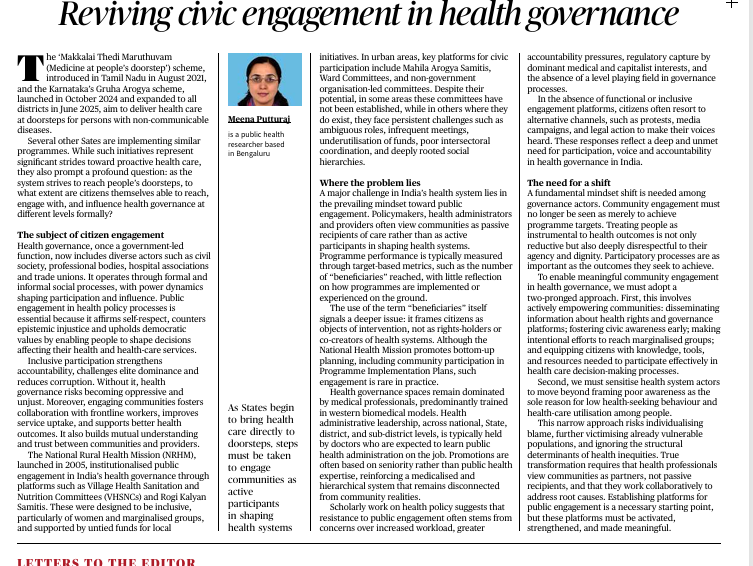Key Points – “A Court ruling with no room for gender justice”
1. Context
- Supreme Court judgment in Shivangi Bansal vs Sahib Bansal effectively endorses suspension of arrest or coercive action under Section 498A IPC.
- Sets a precedent affecting both criminal justice and gender equality.
2. Legal Background
- Section 498A IPC: Penalizes cruelty against a wife by husband or relatives, with imprisonment up to 3 years + fine.
- Enacted to address dowry harassment, domestic violence, and torture.
- Works alongside Dowry Prohibition Act, 1961.
3. Concerns Over the Judgment
- Protection period (“cool-off” 2 months) allows accused to avoid arrest, even when strong evidence exists.
- District-level committees verifying complaints delay justice and deter victims from pursuing cases.
- Blanket protection emboldens abusers and undermines deterrence.
4. Impact on Victims
- Victims of cruelty are often economically and socially vulnerable.
- Delays in investigation discourage complaints, compromise evidence, and create fear of retaliation.
- This ruling risks further marginalizing women in the justice process.
5. Issue of “Misuse”
- Court’s stance influenced by the narrative that Section 498A is widely misused.
- NCRB data shows only 18% conviction rate, but low conviction does not necessarily mean false cases—systemic issues in investigation and social pressures play a role.
- Women’s groups caution that “misuse” is exaggerated and should not weaken protections.
6. Survey Findings
- National Family Health Survey and women’s rights reports highlight persistent under-reporting of domestic violence.
- Burden of proof, societal stigma, and pressure to reconcile deter many women from filing or sustaining cases.
7. Broader Implications
- Judgment risks narrowing the scope of protective laws for women.
- Could signal judicial reluctance to enforce strong gender-protection provisions.
- Weakens consistency and credibility of criminal law protections for women.
UPSC Mains Practice Question
GS Paper 2 – Polity & Social Justice
“The narrative of misuse of gender-protection laws like Section 498A IPC has been used to justify dilution of safeguards, often at the cost of victims’ rights. Critically evaluate this trend in light of recent judicial pronouncements.”
Key Points – “Reviving civic engagement in health governance”
1. Context
- Tamil Nadu’s Makkalai Thedi Maruthuvam (doorstep healthcare) and Karnataka’s Grusha Arogya schemes aim to deliver healthcare at people’s doorsteps.
- Raises the question: Can citizens meaningfully engage with and influence health governance at various levels?
2. Citizen Engagement in Health Governance
- Governance now includes civil society, professional bodies, hospital associations, and trade unions.
- Operates through both formal (policy committees, consultations) and informal (community meetings, local activism) processes.
- Public engagement:
- Affirms self-respect and democratic values.
- Counters epistemic injustice (where people’s lived experiences are undervalued).
- Helps shape decisions affecting healthcare access and quality.
- Affirms self-respect and democratic values.
3. Benefits & Challenges
- Benefits: Improves services, reduces corruption, increases accountability, ensures inclusivity, bridges communication between communities and providers.
- Challenges:
- Tokenistic participation (citizens seen as passive recipients).
- Ambiguous roles, irregular meetings, underfunded committees.
- Bureaucratic mindset focusing on metrics rather than actual community needs.
- Hierarchical systems with weak local empowerment.
- Tokenistic participation (citizens seen as passive recipients).
4. Structural Issues
- National Health Mission promotes bottom-up planning, but implementation is rare in practice.
- Decision-making often dominated by bureaucrats and medical professionals rather than communities.
- Engagement platforms in urban areas are underdeveloped compared to rural areas.
5. Way Forward
- Empower Communities
- Foster civic awareness and rights.
- Provide tools, skills, and spaces for active participation.
- Encourage informed decision-making.
- Shift Provider Mindset
- View communities as co-creators, not just beneficiaries.
- Work collaboratively with citizens to address systemic health inequities.
- Strengthen Platforms
- Ensure active, regular, well-funded citizen engagement forums.
- Remove structural and bureaucratic barriers.
UPSC Mains Practice Question
GS Paper 2 – Governance & Social Justice
“Citizen engagement is critical to achieving equity and accountability in health governance. Discuss the challenges and suggest measures to make such engagement meaningful in India.”



